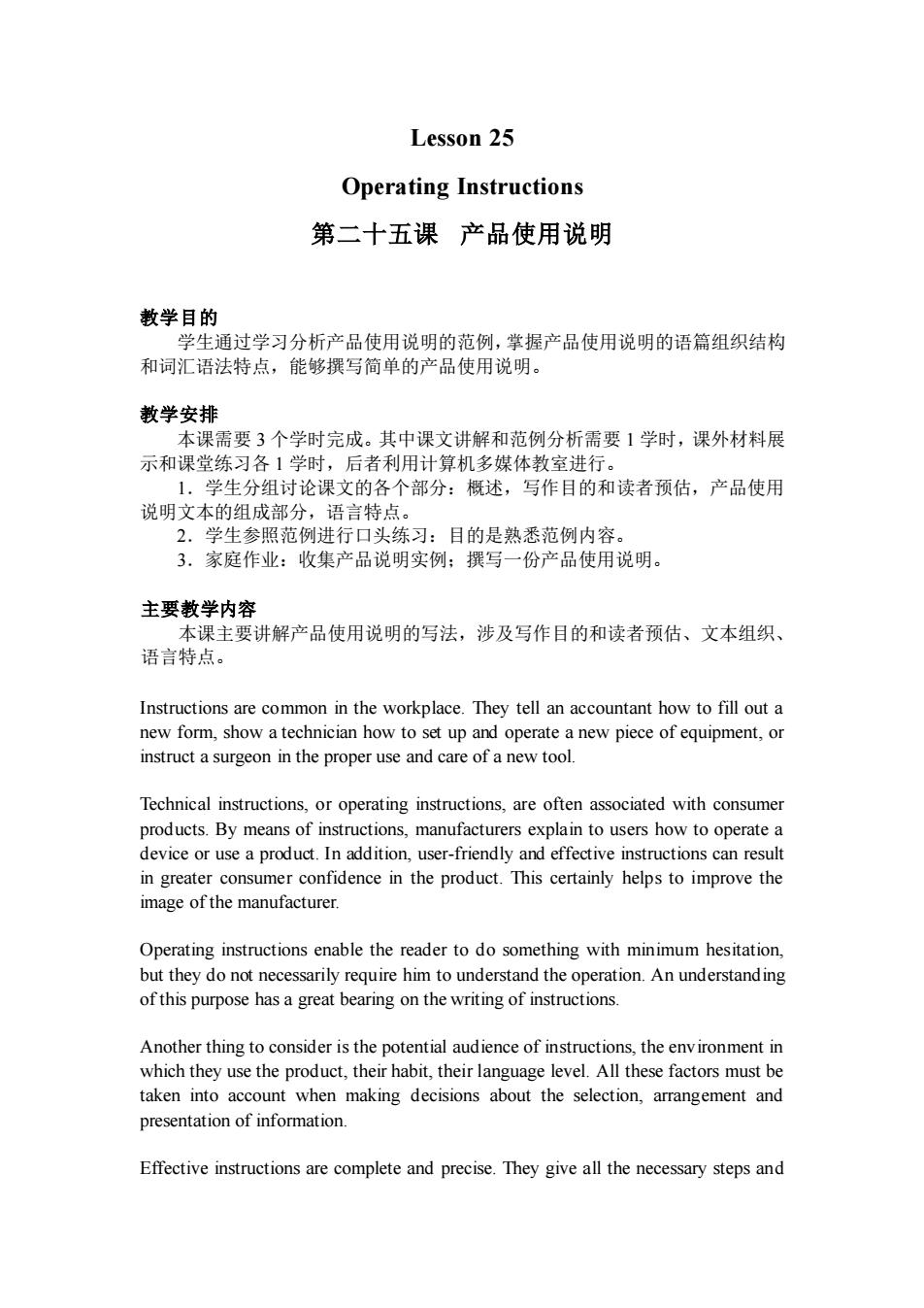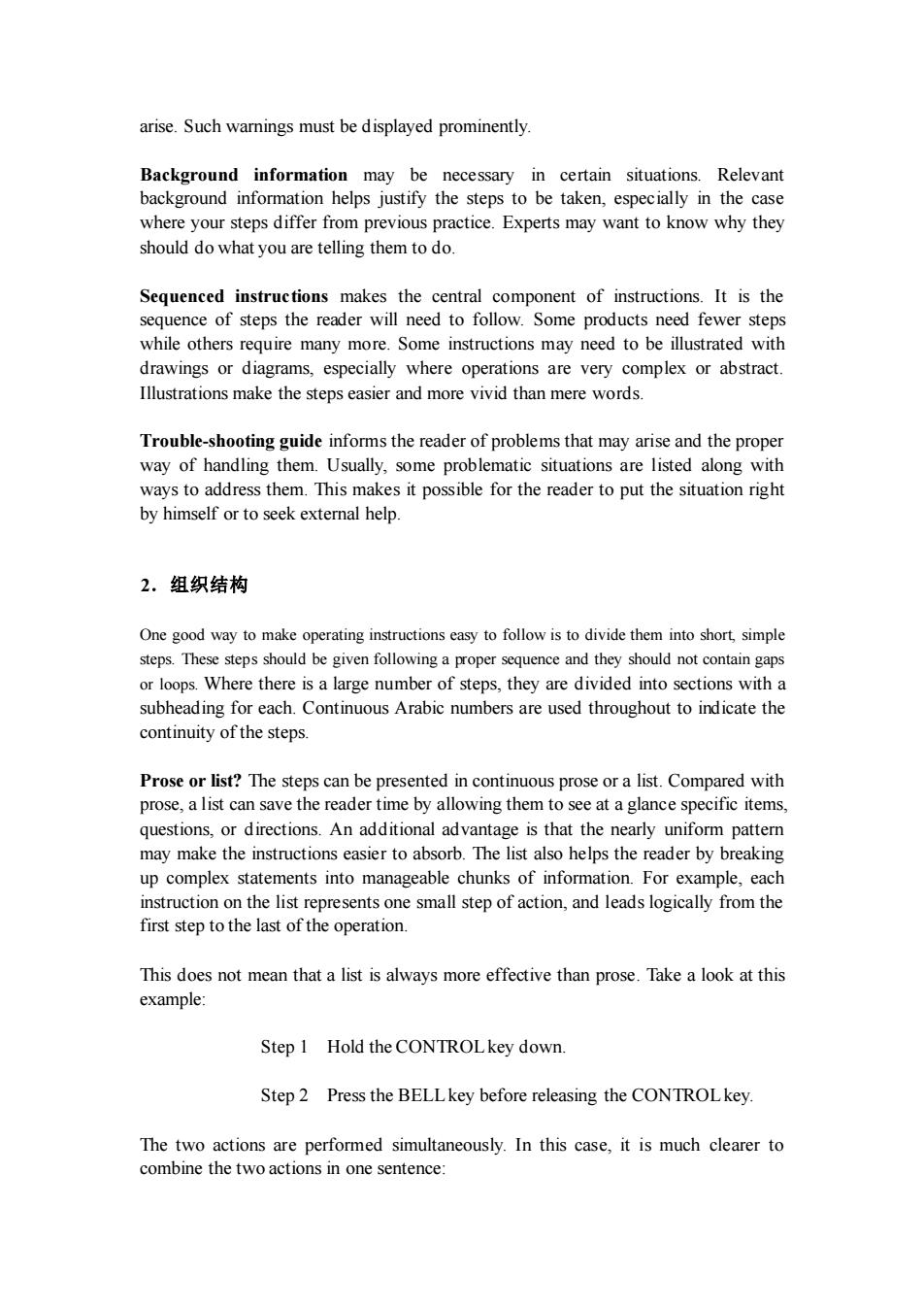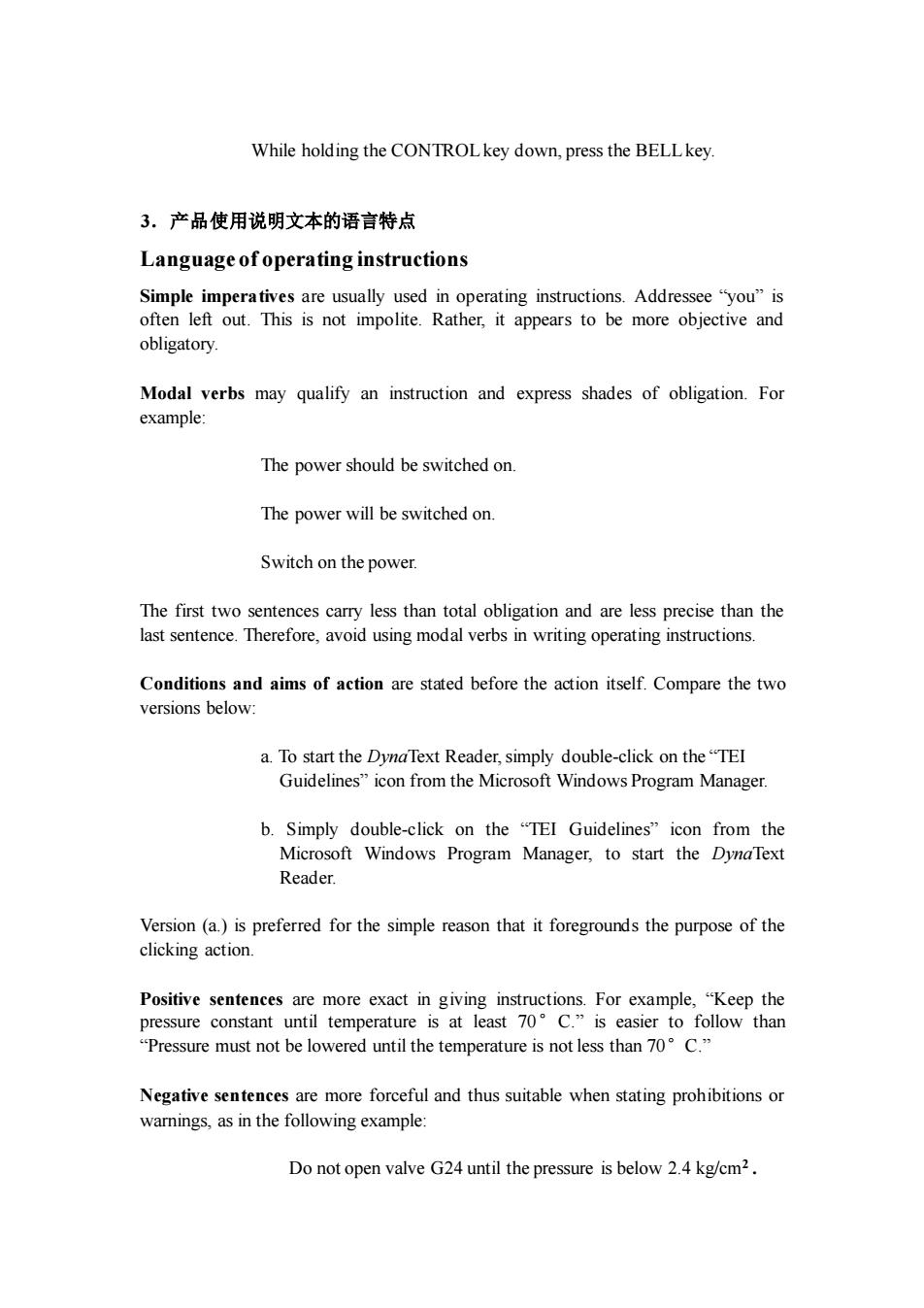
Lesson 25 Operating Instructions 第二十五课产品使用说明 教学目的 学生通过学习分析产品使用说明的范例,掌握产品使用说明的语篇组织结构 和词汇语法特点,能够撰写简单的产品使用说明。 教学安排 本课需要3个学时完成。其中课文讲解和范例分析需要1学时,课外材料展 示和课堂练习各1学时,后者利用计算机多媒体教室进行。 1.学生分组讨论课文的各个部分:概述,写作目的和读者预估,产品使用 说明文本的组成部分,语言特点。 2.学生参照范例进行口头练习:目的是熟悉范例内容。 3.家庭作业:收集产品说明实例;撰写一份产品使用说明。 主要教学内容 本课主要讲解产品使用说明的写法,涉及写作目的和读者预估、文本组织、 语言特点。 Instructions are common in the workplace.They tell an accountant how to fill out a new form,show a technician how to set up and operate a new piece of equipment,or instruct a surgeon in the proper use and care of a new tool. Technical instructions,or operating instructions,are often associated with consumer products.By means of instructions,manufacturers explain to users how to operate a device or use a product.In addition,user-friendly and effective instructions can result in greater consumer confidence in the product.This certainly helps to improve the image of the manufacturer. Operating instructions enable the reader to do something with minimum hesitation, but they do not necessarily require him to understand the operation.An understand ing of this purpose has a great bearing on the writing of instructions. Another thing to consider is the potential audience of instructions,the environment in which they use the product,their habit,their language level.All these factors must be taken into account when making decisions about the selection,arrangement and presentation of information. Effective instructions are complete and precise.They give all the necessary steps and
Lesson 25 Operating Instructions 第二十五课 产品使用说明 教学目的 学生通过学习分析产品使用说明的范例,掌握产品使用说明的语篇组织结构 和词汇语法特点,能够撰写简单的产品使用说明。 教学安排 本课需要 3 个学时完成。其中课文讲解和范例分析需要 1 学时,课外材料展 示和课堂练习各 1 学时,后者利用计算机多媒体教室进行。 1.学生分组讨论课文的各个部分:概述,写作目的和读者预估,产品使用 说明文本的组成部分,语言特点。 2.学生参照范例进行口头练习:目的是熟悉范例内容。 3.家庭作业:收集产品说明实例;撰写一份产品使用说明。 主要教学内容 本课主要讲解产品使用说明的写法,涉及写作目的和读者预估、文本组织、 语言特点。 Instructions are common in the workplace. They tell an accountant how to fill out a new form, show a technician how to set up and operate a new piece of equipment, or instruct a surgeon in the proper use and care of a new tool. Technical instructions, or operating instructions, are often associated with consumer products. By means of instructions, manufacturers explain to users how to operate a device or use a product. In addition, user-friendly and effective instructions can result in greater consumer confidence in the product. This certainly helps to improve the image of the manufacturer. Operating instructions enable the reader to do something with minimum hesitation, but they do not necessarily require him to understand the operation. An understanding of this purpose has a great bearing on the writing of instructions. Another thing to consider is the potential audience of instructions, the environment in which they use the product, their habit, their language level. All these factors must be taken into account when making decisions about the selection, arrangement and presentation of information. Effective instructions are complete and precise. They give all the necessary steps and

details so that the operators can get the job done without unreasonable guesswork. Every detail should be accurate.Such completeness and precision are necessary because operators are to follow your instructions to the letter.Any missing or inaccurate information may lead to disastrous consequences. To achieve these results,you need to understand the task well,analyze your aud ience, choose a proper layout and use language skillfully. 重点讲解 1.围绕本课课文中的范例讲解产品使用说明文本的组成部分 Operating instructions may vary in their length and readership,but they typically consist of the following components: ◇ heading 0 introductory explanation ▣ tools or materials 0 warnings 0 general background ◇ sequenced instructions trouble-shooting guide These components are normally arranged in a sequence of sections,each with its own subheading,which identifies the purpose of the section.Of the sections,the heading, and sequenced instructions are essential while the other parts are optional. The heading is the title of the text.It gives information on what the text below is about.Wording of the heading must be clear and brief. The introductory explanation helps the operator by giving an overview of the operations.It may concern the purpose of the action,what it will achieve,and why this is a useful result.It may also tell him how much ground the instructions intend to cover. Tools or materials usually list any special tools or materials required for the operations.It obviously saves time if the operator can get them ready in advance. Warnings are necessary safety measures for operations.Some tasks involve certain hazards and operators need to be warned against them.General warnings are sometimes given at the end of instructions.We would recommend giving them at the start of the instructions,so that readers may remain alert from the beginning. Warnings concerning specific steps,say materials that are flammable or that give off noxious fumes,are given before he or she reaches the step for which the danger may
details so that the operators can get the job done without unreasonable guesswork. Every detail should be accurate. Such completeness and precision are necessary because operators are to follow your instructions to the letter. Any missing or inaccurate information may lead to disastrous consequences. To achieve these results, you need to understand the task well, analyze your audience, choose a proper layout and use language skillfully. 重点讲解 1.围绕本课课文中的范例讲解产品使用说明文本的组成部分 Operating instructions may vary in their length and readership, but they typically consist of the following components: heading introductory explanation tools or materials warnings general background sequenced instructions trouble-shooting guide These components are normally arranged in a sequence of sections, each with its own subheading, which identifies the purpose of the section. Of the sections, the heading, and sequenced instructions are essential while the other parts are optional. The heading is the title of the text. It gives information on what the text below is about. Wording of the heading must be clear and brief. The introductory explanation helps the operator by giving an overview of the operations. It may concern the purpose of the action, what it will achieve, and why this is a useful result. It may also tell him how much ground the instructions intend to cover. Tools or materials usually list any special tools or materials required for the operations. It obviously saves time if the operator can get them ready in advance. Warnings are necessary safety measures for operations. Some tasks involve certain hazards and operators need to be warned against them. General warnings are sometimes given at the end of instructions. We would recommend giving them at the start of the instructions, so that readers may remain alert from the beginning. Warnings concerning specific steps, say materials that are flammable or that give off noxious fumes, are given before he or she reaches the step for which the danger may

arise.Such warnings must be displayed prominently. Background information may be necessary in certain situations.Relevant background information helps justify the steps to be taken,especially in the case where your steps differ from previous practice.Experts may want to know why they should do what you are telling them to do. Sequenced instructions makes the central component of instructions.It is the sequence of steps the reader will need to follow.Some products need fewer steps while others require many more.Some instructions may need to be illustrated with drawings or diagrams,especially where operations are very complex or abstract. Illustrations make the steps easier and more vivid than mere words. Trouble-shooting guide informs the reader of problems that may arise and the proper way of handling them.Usually,some problematic situations are listed along with ways to address them.This makes it possible for the reader to put the situation right by himself or to seek external help. 2.组织结构 One good way to make operating instructions easy to follow is to divide them into short,simple steps.These steps should be given following a proper sequence and they should not contain gaps or loops.Where there is a large number of steps,they are divided into sections with a subheading for each.Continuous Arabic numbers are used throughout to indicate the continuity of the steps. Prose or list?The steps can be presented in continuous prose or a list.Compared with prose,a list can save the reader time by allowing them to see at a glance specific items, questions,or directions.An additional advantage is that the nearly uniform pattern may make the instructions easier to absorb.The list also helps the reader by breaking up complex statements into manageable chunks of information.For example,each instruction on the list represents one small step of action,and leads logically from the first step to the last of the operation. This does not mean that a list is always more effective than prose.Take a look at this example: Step 1 Hold the CONTROLkey down. Step 2 Press the BELLkey before releasing the CONTROLkey. The two actions are performed simultaneously.In this case,it is much clearer to combine the two actions in one sentence:
arise. Such warnings must be displayed prominently. Background information may be necessary in certain situations. Relevant background information helps justify the steps to be taken, especially in the case where your steps differ from previous practice. Experts may want to know why they should do what you are telling them to do. Sequenced instructions makes the central component of instructions. It is the sequence of steps the reader will need to follow. Some products need fewer steps while others require many more. Some instructions may need to be illustrated with drawings or diagrams, especially where operations are very complex or abstract. Illustrations make the steps easier and more vivid than mere words. Trouble-shooting guide informs the reader of problems that may arise and the proper way of handling them. Usually, some problematic situations are listed along with ways to address them. This makes it possible for the reader to put the situation right by himself or to seek external help. 2.组织结构 One good way to make operating instructions easy to follow is to divide them into short, simple steps. These steps should be given following a proper sequence and they should not contain gaps or loops. Where there is a large number of steps, they are divided into sections with a subheading for each. Continuous Arabic numbers are used throughout to indicate the continuity of the steps. Prose or list? The steps can be presented in continuous prose or a list. Compared with prose, a list can save the reader time by allowing them to see at a glance specific items, questions, or directions. An additional advantage is that the nearly uniform pattern may make the instructions easier to absorb. The list also helps the reader by breaking up complex statements into manageable chunks of information. For example, each instruction on the list represents one small step of action, and leads logically from the first step to the last of the operation. This does not mean that a list is always more effective than prose. Take a look at this example: Step 1 Hold the CONTROL key down. Step 2 Press the BELL key before releasing the CONTROL key. The two actions are performed simultaneously. In this case, it is much clearer to combine the two actions in one sentence:

While holding the CONTROL key down,press the BELL key. 3.产品使用说明文本的语言特点 Language of operating instructions Simple imperatives are usually used in operating instructions.Addressee "you"is often left out.This is not impolite.Rather,it appears to be more objective and obligatory. Modal verbs may qualify an instruction and express shades of obligation.For example: The power should be switched on. The power will be switched on. Switch on the power. The first two sentences carry less than total obligation and are less precise than the last sentence.Therefore,avoid using modal verbs in writing operating instructions. Conditions and aims of action are stated before the action itself.Compare the two versions below: a.To start the Dyna Text Reader,simply double-click on the"TEI Guidelines"icon from the Microsoft Windows Program Manager. b.Simply double-click on the "TEI Guidelines"icon from the Microsoft Windows Program Manager,to start the DynaText Reader. Version(a.)is preferred for the simple reason that it foregrounds the purpose of the clicking action. Positive sentences are more exact in giving instructions.For example,"Keep the pressure constant until temperature is at least 70C."is easier to follow than "Pressure must not be lowered until the temperature is not less than 70C." Negative sentences are more forceful and thus suitable when stating prohibitions or warnings,as in the following example: Do not open valve G24 until the pressure is below 2.4 kg/cm2
While holding the CONTROL key down, press the BELL key. 3.产品使用说明文本的语言特点 Language of operating instructions Simple imperatives are usually used in operating instructions. Addressee “you” is often left out. This is not impolite. Rather, it appears to be more objective and obligatory. Modal verbs may qualify an instruction and express shades of obligation. For example: The power should be switched on. The power will be switched on. Switch on the power. The first two sentences carry less than total obligation and are less precise than the last sentence. Therefore, avoid using modal verbs in writing operating instructions. Conditions and aims of action are stated before the action itself. Compare the two versions below: a. To start the DynaText Reader, simply double-click on the “TEI Guidelines” icon from the Microsoft Windows Program Manager. b. Simply double-click on the “TEI Guidelines” icon from the Microsoft Windows Program Manager, to start the DynaText Reader. Version (a.) is preferred for the simple reason that it foregrounds the purpose of the clicking action. Positive sentences are more exact in giving instructions. For example, “Keep the pressure constant until temperature is at least 70°C.” is easier to follow than “Pressure must not be lowered until the temperature is not less than 70°C.” Negative sentences are more forceful and thus suitable when stating prohibitions or warnings, as in the following example: Do not open valve G24 until the pressure is below 2.4 kg/cm2

Avoid relative words.Relative words such as adequate,suitable,right,etc.do not specify the amount or degree that is required.For example,the relative word “suitable”in“select a suitable amount of the liquid”leaves the reader wondering exactly how much of the liquid to select for the purpose. Avoid ambiguity.The expression "computer trading"is ambiguous in that it could mean trading in computers,by computers,or even for computers. Another source of ambiguity are homonyms.Homonyms are words which are the same in sound and spelling but different in meaning.For example: Check undercarriage locking pin.If bent,replace. "replace"can mean substitute a new part for the undercarriage locking pin or put it back,even in the context.To avoid this ambiguity,it is desirable to choose the exact expression Other sources of ambiguity include pronouns,prepositions and clauses.For example, Please send us a catalog of the goods that you sell with pictures and prices. Is the writer asking for an illustrated catalog of all the goods his reader sells or the catalog of only those goods with pictures and prices?Another example: We sent the brochure to four local firms that had three-color illustrations. It would be clearer to revise it as:We sent the brochure that had three-color illustrations to four local firms. Be careful with technical words.Technical words may make instructions difficult to process.Sometimes,even apparently familiar words may create problems because they carry unusual meanings.For example,the word "tombstone"refers to a stone marker,usually with writing on it,on a tomb or grave.In the context of banking, however,it means a large press advertisement,usually for financial projects,with a hierarchy of inscriptions upon it relating to the importance of each participant's contribution.Readers who are not familiar with this may fail to get the message.To avoid this possible breakdown in communication,try to use more everyday language and define the technical words or "familiar"words carefully
Avoid relative words. Relative words such as adequate, suitable, right, etc. do not specify the amount or degree that is required. For example, the relative word “suitable” in “select a suitable amount of the liquid” leaves the reader wondering exactly how much of the liquid to select for the purpose. Avoid ambiguity. The expression “computer trading” is ambiguous in that it could mean trading in computers, by computers, or even for computers. Another source of ambiguity are homonyms. Homonyms are words which are the same in sound and spelling but different in meaning. For example: Check undercarriage locking pin. If bent, replace. “replace” can mean substitute a new part for the undercarriage locking pin or put it back, even in the context. To avoid this ambiguity, it is desirable to choose the exact expression. Other sources of ambiguity include pronouns, prepositions and clauses. For example, Please send us a catalog of the goods that you sell with pictures and prices. Is the writer asking for an illustrated catalog of all the goods his reader sells or the catalog of only those goods with pictures and prices? Another example: We sent the brochure to four local firms that had three-color illustrations. It would be clearer to revise it as: We sent the brochure that had three-color illustrations to four local firms. Be careful with technical words. Technical words may make instructions difficult to process. Sometimes, even apparently familiar words may create problems because they carry unusual meanings. For example, the word “tombstone” refers to a stone marker, usually with writing on it, on a tomb or grave. In the context of banking, however, it means a large press advertisement, usually for financial projects, with a hierarchy of inscriptions upon it relating to the importance of each participant’s contribution. Readers who are not familiar with this may fail to get the message. To avoid this possible breakdown in communication, try to use more everyday language and define the technical words or “familiar” words carefully

思考题 1.How do you think the purpose and audience expectations bear upon instructions writing? 2.What are the advantages and disadvantages of the two types of text organisation: prose and list? 3.In what ways does the language of instructions differ from that of other types of business writing,like routine requests or business proposals? 练习 1)收集2-3种产品使用说明实例,描述其组织结构和语言特点,写出学习报告。 2)选一种你熟悉的家电产品,用英语写一份使用说明
思考题 1.How do you think the purpose and audience expectations bear upon instructions writing? 2.What are the advantages and disadvantages of the two types of text organisation: prose and list? 3.In what ways does the language of instructions differ from that of other types of business writing, like routine requests or business proposals? 练习 1)收集 2-3 种产品使用说明实例,描述其组织结构和语言特点,写出学习报告。 2)选一种你熟悉的家电产品,用英语写一份使用说明